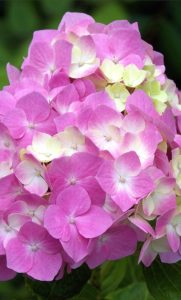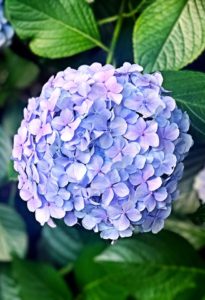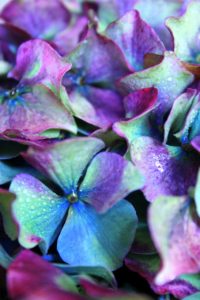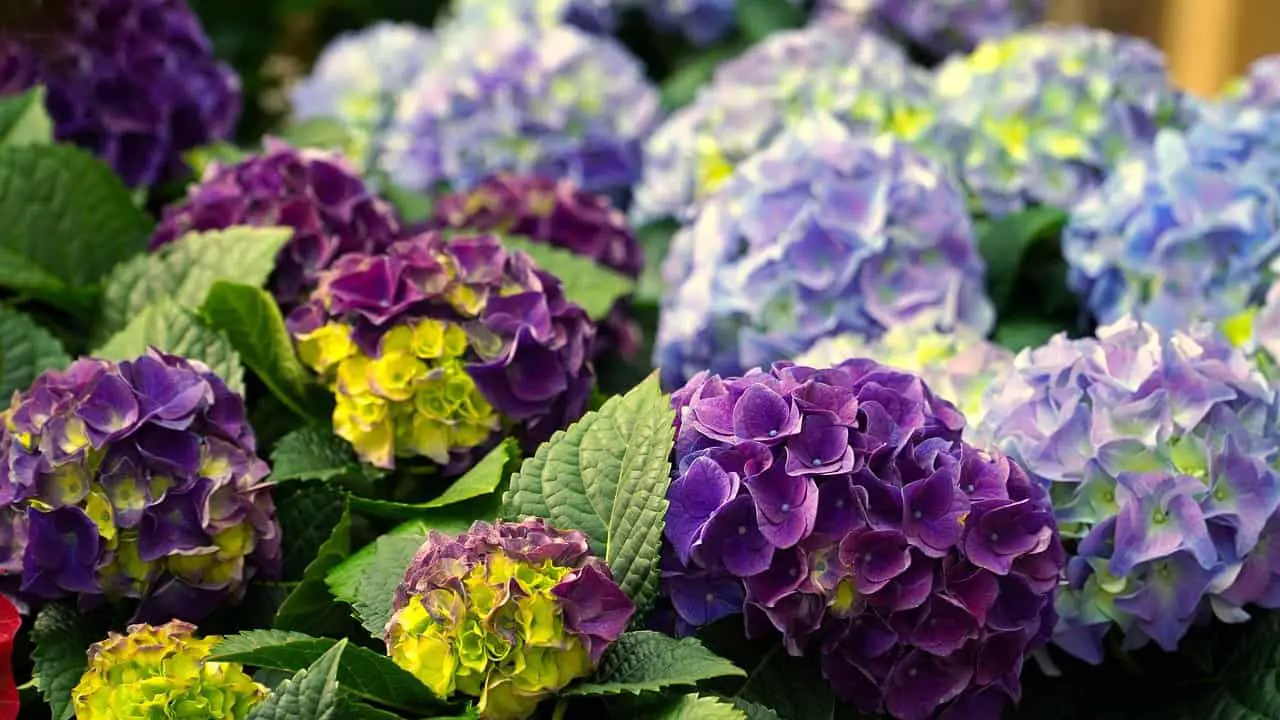Some links in the post are affiliate links and I get a commission from purchases made through some links found in the post.
Hydrangeas can be the most beautiful plants when they are in full bloom. They look stunning in the garden, particularly if we can get them to flower in different colors.
Plants like hydrangeas do best in alkaline soils which makes them bloom in pinks and whites. For a spectacular show of brilliant blue color, we must change the pH of the soil to a more acidic balance.
When added around your hydrangea, the baking soda will help improve water retention and root growth along with reducing fungal diseases and improving leaf production.
Adding baking soda can alter the pH. It will bloom pink or white if the pH of the soil is 6.5 and higher. While levels of 6 and below will bring out blue or lavender blooms.
The bottom line with the color of your hydrangea blooms is all in the soil where you plan on growing the plants.
Alkaline soil will give you pinks and white, while more acidic soil will give blue colors.
The converse also works. If you find your hydrangea is blue and you prefer pinks and white, then altering the pH of the soil to more alkaline will change the color.
Is Baking Soda Good for Hydrangeas?
Apart from altering the color of the flowers, there are several reasons why baking soda should be used in the garden, and particularly good on hydrangeas.
Good for the Roots
Baking soda helps to keep the root system cool. It also helps to make them frost resistant, thus preventing damage from ice. Baking soda works to reduce water loss during the summer months.
Gives the Plant a Boost
Just adding a regular feed of baking soda mixed with water will perk up the leaves and give the plant a healthy look again, particularly if it seems to be drooping.
Reduces Fungal Disease
 You may ask whether adding baking soda will do any damage to your hydrangeas, and the answer is no, it will not harm them. It can even prevent fungal spores from spreading.
You may ask whether adding baking soda will do any damage to your hydrangeas, and the answer is no, it will not harm them. It can even prevent fungal spores from spreading.
If you have any other plants in the garden which are prone to powdery mildew and other leaf diseases, then a dose of baking soda poured over them can help to minimize these issues.
Adding a dose of baking soda to your hydrangea’s diet is one trick I learned from my dad.
While you may not be able to spot the reason for a drooping plant, a drink of this is like a miracle cure. You will notice a change in no time at all.
Will it Make my Hydrangeas Flowers Change Color?
Baking soda is one of the recognised ways to change the color of hydrangeas.
This is because baking soda is at the high end of the alkalinity scale. It will alter the pH level in the soil and therefore change the bloom color.
White hydrangeas are primarily grown in a neutral soil and to keep them that way, you must transplant them into a soil similar to what your plant has been grown in.
If you want to change your white hydrangea (or even your blue ones) to a pinker color then you should add baking soda.
As the baking soda and water mix is absorbed into the root system and then up the stalks you will notice that the flowers become a more vivid pink.
If you’re enjoying this article, check out our article on the common problems with hydrangeas in pots & how to fix them.
How to use Baking Soda to Grow Your Hydrangeas?
There are two ways to add baking soda to your hydrangeas, namely by mixing with the water, and by mixing with the soil around the plant.
It is not a good idea to simply sprinkle the baking soda around the plant because it will not be evenly absorbed and may not do much good.
There is also a chance when sprinkling baking soda around the plant that you get some on the leaves. This can cause them to burn and while it may not harm the plant, it will not look attractive.
Mixing with Water
1 teaspoon in 2 quarts of water should do four good-sized plants.
Mixing with Soil
This is ideally done before you put your plant in the ground, when bringing it home from the nursery or transplant it from pot to ground.
Make sure you mix the baking soda (1 tablespoon) well and evenly distributed through the soil before bedding in your plant.
Adding baking soda to the soil around your hydrangea will give the roots the protection they need from the winter temperatures as well as the summer ones.
Because hydrangeas are such large plants the roots often battle to provide enough moisture for the leaves, so keeping them cool and moist ensures that the plant survives both hot and cold temperatures.
Using as a Fertilizer
If you plan on using it as a fertilizer then make sure that you mix the baking soda with water first. Work on one tablespoon of baking soda per 9 square feet area.
Make sure that the baking soda is completely dissolved before you apply it around the base of the plants.
Try to keep the mixture off the leaves, particularly in the hot weather as it may burn them.
We have a great article here on how to make natural fertilizer for your hydrangeas.
A Word About Overwatering Hydrangeas
 One thing I have learned about hydrangeas is that they like and need quite a lot of water.
One thing I have learned about hydrangeas is that they like and need quite a lot of water.
This is because they can grow large and the roots have a problem getting enough water to feed the leaves at the end.
Equally important to note is that you can overwater them. They don’t like being overwatered either! The best soil around them is moist and not wet.
The reason we tend to overwater our hydrangeas is because in the afternoon heat of the day they seem to wilt.
We automatically assume they have not had enough water and before we know it, they are flooded.
Overwatering hydrangeas will affect the production of blooms on the next cycle. Make sure then, that the water at the base of the plant is moist and not sodden.
Myths about Changing Colors
Over the years it seems that ideas about how to change colors spring up frequently and most of us have tried a few of them.
Because the color of the flower is directly related to the alkalinity or acidity of the soil, it would seem easy enough to alter the pH and change the color.
In effect, what changes the color is the aluminium content in the soil.
Lemon juice
This used to be thought of as the quickest and easiest way to alter the color of hydrangea blooms.
The truth is that you would need several gallons of pure lemon juice to make any difference.
You would also need to constantly add lemon juice to the water. While at some time of the year lemons are cheap, this can run you a small fortune!
Vinegar
The same applies to adding vinegar to your water. You would need to do it every time you water and add a huge amount.
Coffee Grounds
This is a cheaper way to try to change hydrangea color although it is not guaranteed to work. I have tried this method and not had much luck.
You also need to make sure that you watch the soil where you place the grounds as it will go hard with dry grounds and water will not penetrate, thus leaving your hydrangea lacking in water.
I have to say that coffee grounds do work well around my roses, although I still poke holes in the soil around them, so water goes through the grounds which have hardened.
Nails
This is possibly the theory which is the latest way to change color. I have heard of this many times and finally tried it on one of my own hydrangeas. I must admit that nothing happened.
This may have been down to using the wrong type of nails, perhaps old rusty ones would have worked. Mine didn’t change color with this method.
Special Plant Food
If you are set on changing the color of your hydrangea then you will be able to buy special plant food at a good garden centre.
This may work better than all the other theories, as long as you stick to the amounts and frequency of application.
Final Thoughts: How to use Baking Soda to Grow Hydrangeas
 The Nantucket Blue hydrangea is well known for its magnificent blue blooms.
The Nantucket Blue hydrangea is well known for its magnificent blue blooms.
This is because this type of hydrangea responds well to having added aluminium in the soil, and this is done from the start of the plant life.
However, even this variety will change back to pink or white if you transplant it into alkaline soil.
Soil pH is measured from 0-14. The lower numbers show acidity, and the higher numbers alkalinity.
Lemon juice has a level of 2.0 and is classed as highly acidic, with baking soda having a pH of 8.5 – therefore highly alkaline.
Hydrangeas when they bloom are magnificent to see, and certainly brighten up any garden.
If you are fortunate enough to have naturally acidic soil then you will have beautiful blue flowers, while pink blooms will come from soil with low acidity levels.
Either way, using baking soda for your hydrangeas will strengthen the root system and give you a wonderful plant for many years.
Before you go, here are some more related articles I encourage you to read below to help solve more of your gardening issues:
How to Prevent Leaf Scorch on Your Hydrangea
Why Does My Hydrangea Have Small Flowers
How to Landscape with Hydrangeas
Written by: Valerie Holyoak


